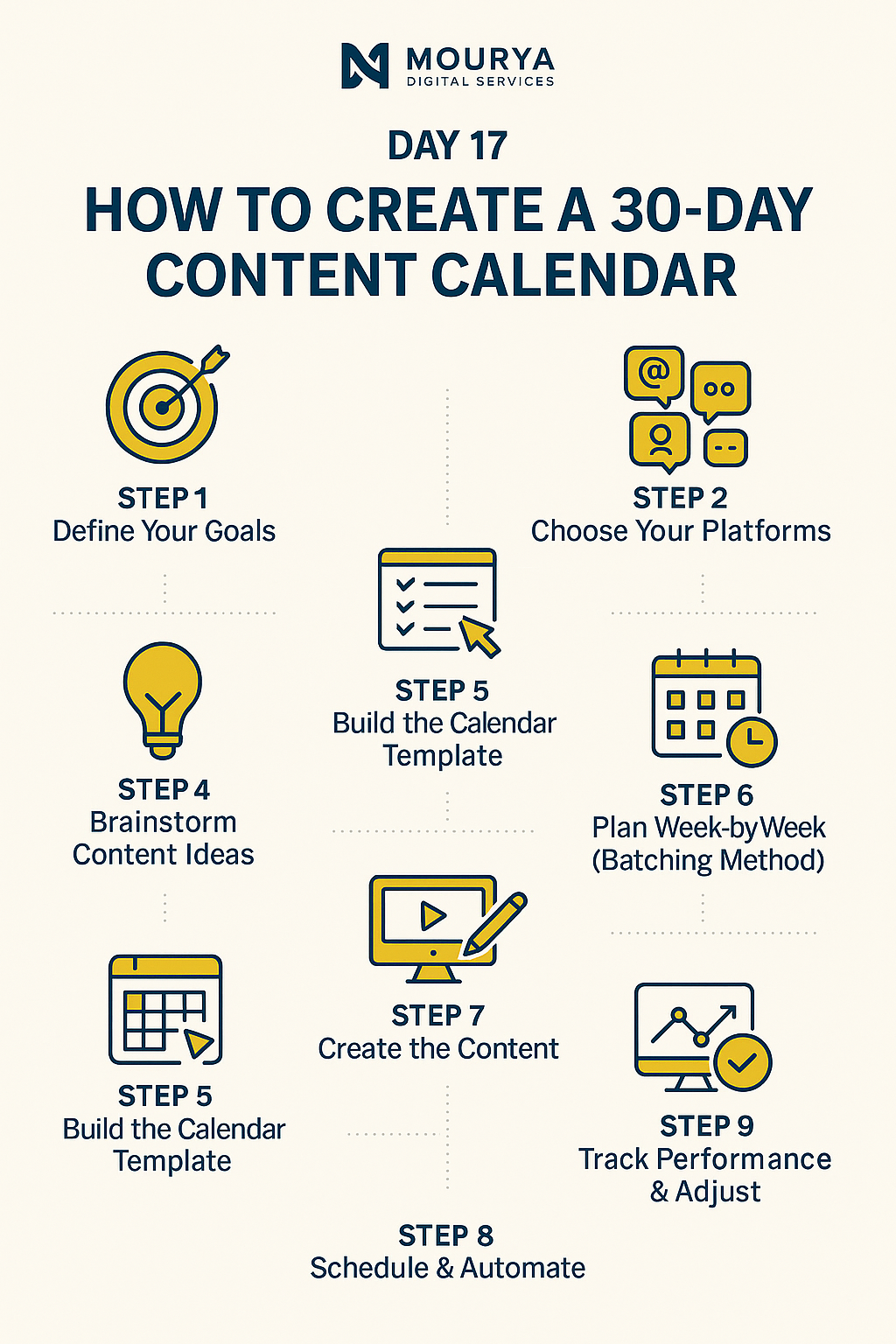
digital marketing, consistency builds trust, authority, and audience loyalty. One of the most effective ways to ensure this consistency is by creating a 30-day content calendar. Whether you’re running a business page, managing a brand, or building a personal brand online, a structured content plan eliminates guesswork, saves time, and boosts results.
In this blog, Mourya Digital Services breaks down how you can create an actionable 30-day content calendar that aligns with your goals and grows your presence across social media, websites, blogs, and other digital platforms.
📌 Why You Need a Content Calendar
A content calendar is a strategic plan that outlines what you’ll post, when you’ll post it, and where it will be published. Benefits include:
✅ Better organization and workflow
✅ Time-saving through batching and scheduling
✅ Aligned content with business goals
✅ Improved consistency and engagement
✅ Clear visibility into marketing themes and promotions
🛠️ Step-by-Step: How to Build a 30-Day Content Calendar
Step 1: Define Your Goals
Start with clarity. Ask:
Do you want to grow followers?
Increase website traffic?
Generate leads?
Educate or entertain your audience?
Every piece of content should connect back to a goal. Mourya Digital Services always begins content planning by aligning it with client objectives — this sets the foundation for high-performing campaigns.
Step 2: Choose Your Platforms
Where is your audience most active?
Instagram – Visual content, reels, stories
Facebook – Community engagement, updates
LinkedIn – B2B content, professional branding
X (formerly Twitter) – News, updates, opinions
YouTube/Shorts – Video tutorials, storytelling
Blog – In-depth educational content, SEO
Pick 2–3 primary platforms based on your audience and capacity.
Step 3: Identify Content Pillars
Content pillars are the core themes you’ll rotate around.
Examples:
💡 Education: Tips, how-to posts, industry insights
🙌 Engagement: Polls, Q&A, user-generated content
🎯 Promotion: Service highlights, offers, case studies
🔁 Behind-the-Scenes: Team culture, work-in-progress
📣 Testimonials/Reviews: Social proof
At Mourya Digital Services, we create 3-5 content pillars per client to maintain variety and brand voice.
Step 4: Brainstorm Content Ideas
Now fill in ideas under each pillar. For example:
| Pillar | Content Idea |
|---|---|
| Education | “5 SEO Tips for Small Businesses” |
| Engagement | “What’s your biggest marketing challenge?” (Poll) |
| Promotion | “Limited-Time Offer on Meta Ads!” |
| Behind-the-Scenes | “Team Brainstorming Session Snaps” |
| Testimonials | “See what our happy client says!” |
Tip: Use tools like ChatGPT, Google Trends, AnswerThePublic, and Instagram Insights to find relevant topics.
Step 5: Build the Calendar Template
Use tools like:
Google Sheets or Excel
Trello
Notion
Canva Content Planner
Buffer or Later (for scheduling)
Columns to Include:
Date
Platform
Content Pillar
Caption/Text
Creative Type (Image, Video, Carousel, Reel, Blog)
Hashtags
Status (Draft, Scheduled, Posted)
Step 6: Plan Week-by-Week (Batching Method)
Instead of planning 30 separate posts randomly, break them into weekly chunks.
Example Week Plan:
| Day | Theme | Platform |
|---|---|---|
| Monday | Educational Blog Post | LinkedIn, Blog |
| Tuesday | Tip Carousel | |
| Wednesday | Behind-the-Scenes | Story or Reel |
| Thursday | Client Testimonial | Facebook, Instagram |
| Friday | Live Q&A Teaser | All Platforms |
| Saturday | Offer/Promo | Instagram, WhatsApp Broadcast |
| Sunday | Recap or Quote Post |
Repeat with variations for the remaining 3 weeks.
Step 7: Create the Content
Design, write, and edit content in batches.
Tools we recommend at Mourya Digital Services:
Canva for creatives
CapCut for reels and video edits
Copy.ai or ChatGPT for caption assistance
Grammarly for proofreading
Google Docs for team collaboration
Step 8: Schedule & Automate
Use content scheduling tools like:
Meta Business Suite (for Facebook & Instagram)
Later, Buffer, Hootsuite, or Publer
Set reminders for manual posts (e.g., Stories or YouTube Shorts) that can’t be auto-published.
Step 9: Track Performance & Adjust
Use platform insights to monitor:
Reach
Engagement
Click-through rate (CTR)
Saves, Shares, Comments
Leads/Sales
At Mourya Digital Services, we review performance every 7 days to tweak content types, posting times, and CTA effectiveness.
📋 Sample Calendar Snapshot (Week 1)
| Date | Platform | Content | Status |
|---|---|---|---|
| 1 Aug | “3 Mistakes in Digital Marketing” Reel | Scheduled | |
| 2 Aug | Blog | “SEO vs. Google Ads: What’s Right for You?” | Draft |
| 3 Aug | Client Review Graphic | Posted | |
| 4 Aug | Poll: “Which platform drives most leads?” | Scheduled | |
| 5 Aug | Instagram Story | BTS from client shoot | Ready |
🎯 Final Thoughts
Creating a 30-day content calendar isn’t just about being active — it’s about being intentional.
At Mourya Digital Services, we believe that great marketing isn’t luck — it’s planned, produced, and polished in advance. A strong calendar gives your brand a voice, consistency, and results.
Need help building your calendar or scaling your digital marketing?
📩 Contact us today at Mourya Digital Services and let’s plan your next 30 days of growth — together.
Let me know if you’d like a PDF version, carousel posts, or editable Google Sheet calendar template for this!